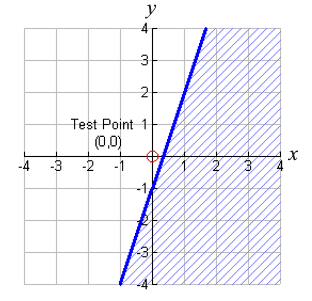|
Solving Linear Inequalities Lesson
y <= 3x - 1
1. First solve the equation (put in slope intercept form) y = 3x - 1 2. Graph the equation (use solid line for >= and <= and a dotted line for > or < 3. Shade the plane above the line for y > or shade the plane below the line for y < For Example - Given the following equation and graph y <= 3x - 1 
If you want to test to see what side to shade we could pick a test point. For example if we picked test point (0,0), we would put that into the equation. y <= 3x - 1 0 <= 0 - 1 0 <= -1 Since the equation evaluates to be false, 0,0 is not part of the solution set and that side of the graph should not be shaded. If you picked point (3,3), you can see that that point does work. 3 <= 3(3) - 1 So the side of the line containing that point should be shaded. Another way to look at this : if y <= 3x - 1 when x = 2 then y <= 5. So we can graph a line from point (2,5) down, because y is less than 5. If we continue drawing lines down for each value of x, we get our shaded area. |